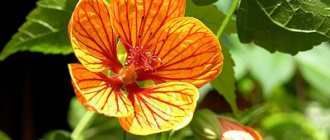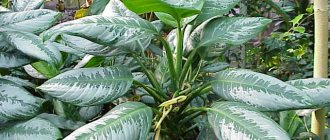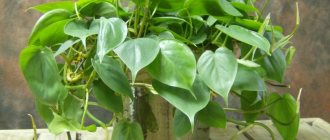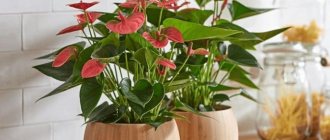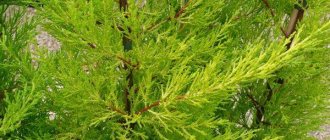Sanchezia is a decorative deciduous shrub from the Acanthus family. The perennial plant is of great interest with its succulent emerald leaves with beautiful lemon stripes.
The height of Sanchetia even indoors can reach more than a meter if the top is not cut off. The shrub grows quickly, with up to 7 new leaves appearing on the tetrahedral shoots every year. Sanchetia blooms in summer, its elongated tubular flowers are collected in a spike-shaped inflorescence. Under natural conditions, it is distributed in the tropical zones of Ecuador, Peru, and Colombia, and Brazil is considered the birthplace of Sanchetia, from where in the 18th century. was brought to Europe.
Be sure to check out the plants from the Acanthaceae family, Ruellia and Whitefeldia.
| High growth rate. 6-7 new leaves per year. |
| Blooms in summer at high temperatures and high humidity. |
| Easy to grow. |
| Perennial. |
Sankhetia: care at home. Briefly
Growing sanchetia at home is quite simple, the main thing is to create optimal conditions for good plant growth:
| Temperature | In winter – not lower than + 14°C, in summer – about + 23°C. |
| Air humidity | Above 55%, spray and wipe the leaves with a napkin. |
| Lighting | Diffused bright light; southeast windows. |
| Watering | In winter - once every 14 days; in summer - sometimes up to three times a week; The surface of the soil should dry out between waterings. |
| Soil for sanhecia | Universal ready-made soil for plants; substrate from turf soil, peat, garden soil, sand, taken in equal parts. |
| Feeding and fertilizer | In spring and summer - liquid fertilizer for decorative foliage plants diluted with water, twice a month. |
| Transplanting Sanchetia | Young bushes - every spring, adults - every two years. |
| Reproduction | Seeds or cuttings. |
| Features of cultivation | The shrub develops very quickly. Therefore, every spring it is pruned, removing almost ¾ of the shoots. Sanhetia needs fresh air. The room in which it is located is regularly ventilated; in the summer, the bush is taken out onto the balcony, covered from drafts and shaded from the scorching sun at noon. |
Trimming
Sanhetia grows very quickly. In order not to end up with a tall single-stem plant instead of a bush, it is necessary to carry out pruning in a timely manner. This is at the same time the formation of the crown of the bush.
Pruning is carried out in the spring. You can cut any branches, forming the shape you need - the plant will very quickly grow fresh shoots and leaves.
It is also necessary to pinch the tops of the stems, but keep in mind that the young leaves of the plant will no longer be as large as they grew on the main stem.
After pruning, watering is slightly reduced, since the risk of water stagnation in the pot increases.
Caring for Sanchetia at home. Details
Sankhetia is still a rare guest in apartments. If you can create pleasant conditions for the plant, your tropical guest will admire the beauty of the painted leaves and bring harmony to the house.
Bloom
Sanchetia blooms in the summer.
Showy tubular flowers with orange bracts, lemon-colored. They are formed at the very bases of the leaf blades and are collected in vertical spike-shaped inflorescences. The upper edge of the flower is coquettishly folded back, exposing graceful long stamens. Flowering is original, but after it the shoots become thinner, become decrepit, and the leaves lose their decorative effect. To avoid this, shoots are pruned in early spring, but two shoots are left in the center of the plant to enjoy the unusual appearance of eye-catching inflorescences. In its natural environment, Sanchetia is pollinated by hummingbirds. After flowering ends, a fruit appears in the place of the inflorescences in the form of a box with small seeds.
Temperature
Homemade sanchetia is a very heat-loving plant. In order for the leaves to retain their beauty, it is important to maintain the correct temperature. In summer, the shrub is comfortable at + 20 - 22° C. If it is hotter, the plant will drop its leaves lifelessly.
In winter, the tree is kept at normal room temperature. It is necessary to ensure that the mercury column of the thermometer does not fall below + 13° C. Sanchetia does not react well to drafts and temperature changes.
Spraying
It is not always easy to organize proper care for a tropical plant indoors. Sanchetia at home must be kept at high humidity. To do this, spray the bush and bathe in the shower.
During flowering, moisture should not be allowed to get on the bracts: irrigation will lead to their rotting. In this case, a high level of humidity is maintained by other methods: turning on air humidifiers; the flowerpot is placed on a tray with wet pebbles; An open container of water is placed next to it.
Periodically wipe the leaves with a damp soft cloth.
Lighting
One of the reasons for the poor survival of tropical plants in an apartment is improperly selected lighting. A shrub with original leaves, having tropical roots, can adapt to life in partial shade, but the beauty of the leaves will fade from lack of light. Therefore, it is best to place Sanchetia at home in a south-eastern or eastern window, where the plant can receive bright, diffused light in the required quantity.
On a south window on a hot afternoon, the bush is shaded, protecting the leaves from possible burns. A window facing north is absolutely not suitable for the plant: the shoots will stretch out, the already small flowers will be crushed, and most importantly, the beauty of the leaves will disappear (the color will fade, the stripes may disappear).
Watering Sanhetia
Sometimes it can be difficult to keep the measure when watering a tropical plant.
Knowing that the green pet loves moisture, the owner strives to water it as often as possible. As a result, the flower may wither due to waterlogging. As recommended by the rules for caring for sanchetia, at home the flower is watered when the upper part of the substrate dries out by about 10 mm. In summer this happens often - up to twice every 7 days. If the bush does not have enough moisture, it will drop its leaves. The situation can be quickly corrected by watering the sanchetia abundantly and putting a plastic bag on it for several hours. The flower will quickly restore its tone. In winter, Sanchetia is watered less frequently - usually once every 10 - 13 days.
Water with well-settled lukewarm water. Excess water from the pan is poured out so that the roots of the plant do not touch the moisture. The tree trunk circle is mulched with coconut substrate, crushed bark or moss to retain moisture longer.
Sanchetia pot
The correct choice of flowerpot contributes to the normal location of the root system, which means the harmonious development of the plant. Given the large rhizome of Sanchetia, choose a large pot for it, with several drainage holes at the bottom. When choosing the height of the pot, do not forget about a thick layer of drainage that needs to be poured onto the bottom.
In such a container, the roots of the shrub will breathe well and the threat of moisture stagnation will be reduced.
Priming
Sanhetia will develop harmoniously if the soil is selected correctly. It should be not only nutritious, but also loose. A universal plant substrate with neutral or slightly acidic acidity is suitable.
Many gardeners prepare the soil mixture themselves, taking the same amount of garden soil, peat, sand and turf soil. To enhance looseness, vermiculite, agrovermiculite, brick chips or crushed sphagnum are added to the mixture. If you add coconut substrate, the soil for sanchetia will be fluffy and breathable.
Feeding and fertilizer
To ensure that the bush is healthy and its leaves remain beautiful and bright, fertilizing and fertilizer are used during active growth. Every 14 days, from March to early September, sanchetia is fertilized with a product for decorative foliage plants diluted by half.
The product must contain a complex of microelements. It is worth carefully studying the label on the bottle and making sure that nitrogen is not in the first row in the list of elements. An excess of this component can lead to monochromatic and faded leaves. Feed after evening watering. After completing the procedure, the sanchetia is shaded. In winter, feeding is stopped.
Transfer
Young plants are replanted every spring.
More mature sanhetia require transplantation less often - it is carried out every two years. It is difficult to replant a mature bush without damaging the roots. Therefore, replanting is replaced by transshipment, and over time, without replanting the plant, the top layer of the substrate is refreshed. Transplant the sanchetia into a larger pot that has drainage holes at the bottom. The plant is planted without deepening the root collar. After the procedure, the leaves of the bush often drop. To restore their tone, water the flower well and put a plastic bag on top. This technique allows the bush to quickly recover. After transplantation, the sanchetia is kept in the shade for several days so that it recovers from stress.
Feeding is resumed after 21 days.
How to prune Sanchetia?
Sankhetia is growing rapidly. If growth is not slowed down in time, it will turn into a giant plant. To regulate growth and form a beautiful crown, the bush is pruned every spring. Taking a pruner in your hands, you can act decisively, without being afraid to cut off the “excess”: the plant will quickly grow new shoots.
Shoots are pinched regularly. It is important to know that the new leaves will not be as large as the previous ones. But if you form a single-stemmed shrub by removing the side branches, there is hope of getting large leaves.
After pruning, the number of waterings is reduced so that moisture does not stagnate.
Rest period
From mid-November to the first half of February there is a dormant period for Sanchetia. The plant needs this time to accumulate wasted energy and maintain the decorativeness of the leaves at a high level. Sankhetia should completely relax and rest.
At this time, reduce the number of waterings, lower the temperature and stop feeding. Random stimulation will lead to complete depletion of the bush's strength.
Growing
Sanchetia is a large, fast-growing plant. To grow it, you need a fairly spacious container. Bright exotic plants are replanted annually; it is advisable to carry out this procedure in the spring. This should be done very carefully, using the transshipment method.
Pinching and pruning can give the plant a more attractive shape. After flowering, when Sanshetia loses its decorative effect, it is recommended to remove shoots without leaves. Then the plant will quickly restore its beautiful appearance.
Sanshetia positively perceives the application of organic and mineral fertilizers. Preparations rich in nitrogen are especially useful for it.
Propagation of Sanchetia by cuttings
The seeds of the plant cannot be obtained at home; it is difficult to buy them. At home, only propagation of Sanchetia by cuttings is possible. After spring pruning, strong, beautiful cuttings are selected. Sections can be treated with a root formation stimulator. The lower leaves are removed. Planted in a damp substrate and covered with cellophane.
Keep at + 24° C, watering and ventilating the seedling. After about 20 days, rooting will occur (this will be visible by the formation of new leaves). After this, the film is removed and the plant is transplanted into a large container.
Diseases and pests
If plant care is irresponsible, it is often attacked by pests, and diseases attack the weak flower. Unpleasant symptoms occur:
- the tips of Sanhetia leaves dry out - due to low air humidity (sprayed, placed on a tray with wet expanded clay);
- Sanchetia leaves fall off - keeping the plant in the heat or cold; exposure to draft; prolonged lack of watering; watering with cold water (change maintenance conditions, adjust watering);
- brown spots on the leaves of Sanhetia - from sunburn (shade on a hot afternoon in the sun);
- the base of the stems rots - from watering with cold water and excess moisture (adjust watering, water only with warm water);
- Sanchetia grows slowly - lack of nutrients (renew the soil, feed).
Sometimes Sanchetia is attacked by insects: scale insects, mealybugs, aphids, spider mites. Insecticides will save you from pests.
Types of Sanchetia homeis with photos and names
There are about 60 species of Sanchetia in nature. Two of them are common in home culture.
Sankhetia Noble
The height of the bush is about 2 m. Large, rich green leaves, “decorated” with lemon veins, have an elliptical shape. They are located parallel on thick tetrahedral shoots and are marked with a clear gloss. Yellow flowers are collected in an elongated inflorescence - a spike.
Sanchetia microleaf
A shrub whose height rarely exceeds 0.9 m. Thickened shoots are painted bright brown. The elongated, elliptical emerald leaves are covered with thin golden veins, while the middle vein at the bottom has a red tint.
The noble beauty of sanhecia gives a finished look to the interior, visually softens the sharpness of the corners and creates a favorable atmosphere in the house.
Description of the plant
- This flower has leaves of a bright, rich green hue. They are big enough. The length varies from twenty-eight to thirty-one centimeters, and the width reaches twelve centimeters. If properly cared for, they will be smooth and shiny.
- If you look closely, you can see veins of a milky white hue. In indoor conditions, the plant can grow up to one hundred to one hundred and twenty centimeters.
- If you create the right conditions, maintain the right temperature, normal humidity, and carefully monitor the substrate in which the plant is located, then you can not only delight yourself and the guests of your home with such a beautiful flower, but also give it as a gift for various holidays.
- No one will be indifferent to the golden, yellow, lemon and amber flowers, which are collected in inflorescences.
- In accordance with the classification, inflorescences are classified as ears. If the flowers are pollinated by insects, then fruits appear, which according to the classification are classified as capsules.
Although the plant has so many advantages, there are also significant disadvantages. However, many people simply call them features.
For example, as soon as the flowering period ends, sanchetia ceases to be a highly decorative flower. It is very noticeable how the shoots begin to age. An equally noticeable phenomenon is the falling of leaves.
However, while the plant is blooming, it creates an indescribable atmosphere of comfort in the room. Thanks to their varied leaves and equally unusual flowers, they will perfectly brighten up both strict apartments and completely home ones.
An exotic flower will look good both against the background of bright wallpaper and against the background of simple white walls. It is good to use especially in those apartments that do not have a lot of furniture. After all, it creates a feeling of emptiness. Sankhetia quickly deal with the situation.
Despite its versatility, few people know about this amazing perennial. Even those who have long been interested in floriculture do not know about its existence. The reason is that there is little talk about it and few places where it is mentioned. Even in a flower shop it is very rare to find it.



